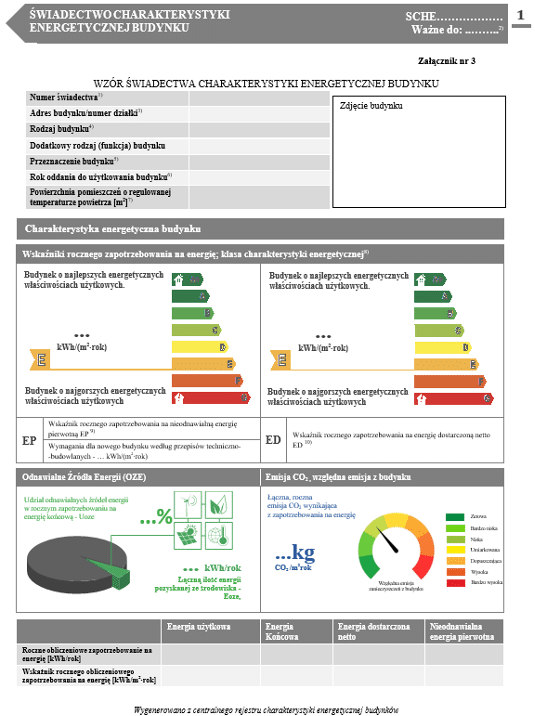Energy performance certificates constitute an essential element of the European Union’s energy and climate policy. Poland currently applies monthly methodology, however, according to new regulations, from June 30, 2026, implementation of more accurate hourly methodology for non-residential buildings is planned (for residential buildings, monthly methodology may still be used), which will affect new energy performance certificate results. What impact will this have and what other elements will be introduced? This article presents a compilation of the most important changes that will be introduced and the benefits and risks arising from them.
New Hourly Methodology
One of the most important changes is the modification of the methodology for calculating energy demand. The new regulation, which is to come into force at the end of June 2026, will introduce an hourly method based on the PN-EN-ISO-52016-1 standard. The standard defines general assumptions, boundary conditions, and a set of equations used to calculate – under dynamic conditions, with hourly or sub-hourly time steps – parameters of the building’s internal climate, such as air temperature, operative temperature, as well as instantaneous thermal loads related to heating, cooling, humidifying, and dehumidifying air. These calculations are performed for a single building zone, assuming maintenance of specified thermal and humidity comfort values. Importantly, the standard does not impose a specific calculation tool or computer technology – leaving freedom in software selection, provided it meets accuracy requirements. This approach will significantly improve the precision of forecasting actual energy consumption in buildings.
Description of Monthly Methodology
The monthly method is based on averaged values of climatic conditions and energy demand on a monthly scale. It is relatively simple to implement and fast in calculations, however its accuracy is limited. It does not account for hourly variability, which can lead to underestimation or overestimation of actual energy consumption. When calculating energy demand, the average monthly temperature difference between internal and external environments is calculated, which translates in further stages to energy demand. As a result of this and several other aspects, we cannot compare certificates with actual energy consumption, which is then visible on the bill. Certificates are meant to be a tool that allows comparing the energy efficiency of buildings, but should not be compared with the actual energy consumption of the entire building.
Climate Data – External Temperatures
Currently, for calculating certificates and parts of energy audits, typical meteorological years 1971-2000 are adopted, which were determined in 2004.
However, the climate is warming and significant changes in average monthly and annual temperatures are observable. The topic of updating climate data currently adopted for calculations has been discussed for a long time, including at the thermomodernization 2023 forum.
Impact of Methodology Change on Heating Demand
If the base year for which climate data is currently adopted were not changed and only hourly data were used, an increase in heating demand of approximately 5% per year is estimated. This results from considering extreme temperatures that occur or occurred in winter months.
However, if new current climate data were adopted, a significant reduction in heating demand of even several dozen percent is estimated.
Impact of Methodology Change on Cooling Demand
Currently, results on certificates show very low cooling demand, which results from the necessity of using average monthly temperature, which in the warmest month, e.g., for Warsaw, is 19.2°C. Consequently, the calculated cooling demand for ventilation and resulting from heat penetration is underestimated.
If we analyze hourly temperatures and consider high instantaneous temperatures that occur during the day when the building is most intensively used, significantly higher useful energy demand for cooling is expected.
Additionally, due to the warming climate, a significant increase in cooling demand is also predicted. Hourly calculations after considering climate data updates will then be much closer to actual energy consumption.
This will translate to increased primary energy demand and emissions due to the use of electrical energy for cooling production, which is characterized by a high non-renewable primary energy factor (wi=2.5) and CO2 emission factor.
Other Important Issues in the New Regulation
Energy Classes
Energy classes from A+ (best) to G (worst) will appear, which are assigned depending on the achieved EP and ED indicators for the building. The class division is detailed in the Draft Regulation and updated on June 6, 2025. Currently, changes have appeared resulting from public consultations in Q3 2024, which among other things changed the ranges of individual classes.
Below are presented the EP values for building of different function for classes A and C:
Table 1. Energy classes A and C according to the Draft Regulation in relation to EP.
| Building Function | Class A* EP ≤ | Class C EP ≤ |
|---|---|---|
| Single-family residential building | 68 | 117 |
| Multi-family residential building | 63 | 107 |
| Collective residence building | 135 | 184 |
| Public utility building – healthcare | 239 | 304 |
| Public utility building – others | 108 | 165 |
| Economic, warehouse and production building | 131 | 180 |
*Additionally, classes A+ and A correspond to buildings producing zero carbon dioxide emissions on-site from fossil fuels.
Source: Government Legislation Center – Draft regulation of the Minister of Development and Technology on the methodology for determining the energy characteristics of a building or part of a building and energy performance certificates
ED Indicator
Net delivered energy indicator. It will be calculated based on the balance of energy consumed on-site and exported – concepts of exported final energy and delivered final energy will be introduced. The methodology introduces a detailed indicator that will determine the actual energy demand for the building without considering energy surpluses, e.g., from photovoltaic installations.
In case of energy surpluses, it will be effective to use energy storage systems, which will allow spreading surpluses over time. It can be seen that this is an appropriate step toward energy storage technologies, which are currently becoming increasingly popular solutions and in the new methodology will have significant potential for improving energy efficiency indicators. The topic of energy storage also appeared in the new draft Technical Conditions, where an entire chapter defining conditions for installing energy storage was introduced.
RES Share
Certificates feature the Uoze indicator, for which the methodology will now be deepened. The new methodology describes in detail how to calculate final aerothermal, geothermal and hydrothermal energy and includes this energy in the balance and RES share. A new graphic representing the share of RES energy for the building will appear on the first page.
CO2 Emissions
On the first page of the building certificate, a CO2 emission indicator/(m2*year) will also appear, which will also have graphics and division into 7 emission levels: from very high to zero in appropriate colors.
Detailed Recommendations
The regulation will also include the possibility of performing detailed recommendations, which will indicate building possibilities along with performing energy and economic analysis for the project. Then the project cost, effect on reducing energy consumption and emissions, and payback period will be estimated. This is a type of energy analysis that may replace energy audits in the future for some funding programs.
New Certificate Appearance
The regulation defines a new appearance of the document, which will contain more information and will no longer have a bar with the EP result.

Figure 3. First page of new certificates
Source: Government Legislation Center – Draft regulation of the Minister of Development and Technology on the methodology for determining the energy characteristics of a building or part of a building and energy performance certificates
What More Can We Expect Next Year?
• In case of climate data updates: Expected decrease in useful energy demand for heating, but increase in cooling demand due to the application of more accurate hourly temperature data and climate warming.
• Introduction of energy classes (A+–G) for individual building functions – Facilitating comparison of buildings in terms of energy efficiency.
• New ED indicator (net delivered energy) – Additional parameter for assessing building energy efficiency.
• Detailed RES share calculations – Including distinction of aerothermal, geothermal and hydrothermal energy.
• Building CO2 emissions – graphical representation and division into 7 emission classes from very high to zero.
• Performing detailed modernization recommendations – Possibility to develop a detailed building renovation plan with economic analysis.
• New way of presenting data on the certificate – The first page will contain: EP, ED, RES share, CO₂ emissions – presented graphically and coloristically.
• Compliance with the EPBD directive.
Who Will Be Affected by the Changes?
• Persons performing energy performance certificates.
• Energy auditors.
• Designers preparing technical projects within construction documentation.
Risks:
• Increased costs of preparing certificates in initial periods resulting from: need to purchase new calculation programs, training, and potentially greater work effort when performing calculations.
• Extension of implementation deadlines in the initial period of regulation enforcement.
• Risk of errors resulting from lack of experience or unadapted new tools.
• Increased energy demand, which will be closer to actual consumption, particularly in terms of cooling demand.
Benefits:
• Higher quality of calculations.
• Better certificate transparency.
• Better representation of actual energy consumption.
• Possibility to develop a comprehensive renovation plan (with analysis of costs, savings, emissions and investment return).
• Unification of methodology in the EU – easier comparison of buildings between member states and compliance with the EPBD directive.

Szymon Krawczyk is an energy transformation expert and ESG advisor with several years of experience in energy efficiency. He supports enterprises in achieving climate goals, reducing greenhouse gas emissions, and lowering operational costs through the implementation of modern energy solutions.
He specializes in developing net-zero strategies, conducting energy audits, preparing energy performance certificates, thermographic surveys, and building energy modeling. He also has experience in securing funding for thermomodernization projects.
He graduated from Warsaw University of Technology with a degree in civil engineering, specializing in sustainable construction. He combines technical knowledge with a strategic approach, supporting clients in creating sustainable business models that align with both their individual goals and ESG requirements.
